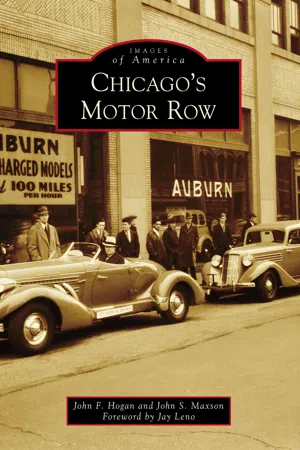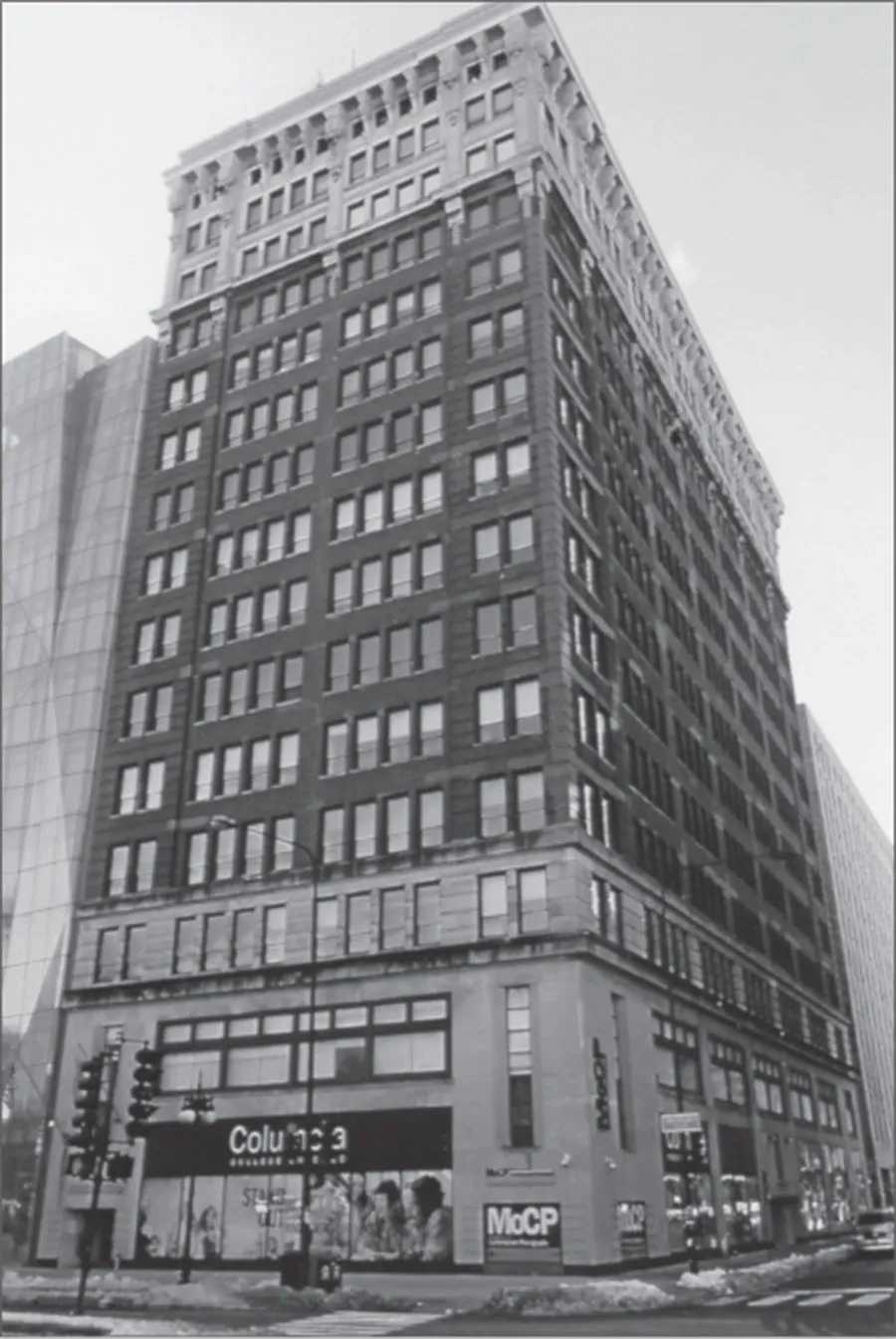![]()
One
STREET OF DREAMS
Chicago’s Motor Row was the product of multiple dreams, experienced independently of one another, that converged on the city’s near South Side between roughly 1905 and 1936. Visionaries such as Henry Ford, James Packard, and others dreamed of a new way to sell this comparatively new phenomenon called the automobile that was remaking America. To master architects such as Christian Eckstorm, Albert Kahn, and more, the demand for distinctive auto showrooms presented opportunities to dream small and cap their portfolios of more ambitious structures with small jewels. Advertising professionals who trafficked in sizzle as much as steak sold dreams along with the vehicles that would ostensibly fulfill those dreams. Most significantly, American consumers stood ready and eager to buy into the dream of owning their own modern form of transportation that could take them farther, faster to places they would never visit or maybe never heard of. The automobile had become the preeminent symbol of upward mobility, and more than a hundred of them, in every size, price, and style, waited right there on S. Michigan Avenue, inviting buyers to take that first ride.
THEN AND NOW. This photograph and the one on the opposite page, taken more than a century apart, show a section of early Motor Row that doesn’t appear to have changed much. The cameras look north from Sixteenth Street, a demarcation line between the smaller, plainer dealerships that comprised the first automotive inhabitants and the larger, flashier buildings that took shape as the row advanced south. The one-time Ford and Buick dealerships are virtually indistinguishable in the upper left. (Courtesy of Chicago History Museum.)
CHICAGO, HOME OF THE SKYSCRAPER. While the development of Chicago’s downtown area only a few blocks away saw older buildings replaced with modern commercial and residential high-rises, the value of real estate on S. Michigan Avenue languished, providing little incentive to replace one-time auto dealerships with more modern architecture. Hence, many Motor Row structures have survived multiple spurts of economic growth that doomed other historic buildings farther north. (Photograph by John F. Hogan.)
FROM MANSIONS TO MOTORS. Looking north from Twenty-Seventh Street, about a mile and a half south, provides a view of Michigan Avenue before the advent of Motor Row and later the Stevenson Expressway. Mansions gave way, sometimes grudgingly, to the southward expansion of auto dealerships. (Courtesy of the David Kerr collection.)
STABLES FOR CARS. The earliest auto dealerships were said to have a lot in common with stables that doubled as garages and repair shops. Built in 1892, the Pullman stables at 11201 S. Cottage Grove Avenue accommodated horses owned by the more affluent residents of George Pullman’s “model town.” Later, the facility became a gas station/repair shop called the Pullman Motor Stables. The now-unoccupied building remains largely unchanged. (Photograph by John F. Hogan.)
FORD WAS FIRST. It is altogether fitting that the first dealership on Motor Row was designed by the architect who lent his name to the most buildings on Motor Row (12), Christian Albert Eckstorm. Eckstorm’s bold, clear lines have endured well at 1444 S. Michigan Avenue, the oldest surviving building on Motor Row. Henry Ford located one of his first dealerships outside Detroit here in 1905, when his company was only in its third year. Business thrived. Before the advent of the assembly line, cars sold faster than the factory could turn them out. Competitors took note, moved nearby, and the development of Motor Row was underway. The Ford team left the two-story building in 1913 for larger quarters a few miles south. The 1444 location is the oldest surviving building on Motor Row and is now occupied by an eye care concern. (Photograph by John S. Maxson.)
MODEL TS AND THEN SOME. This 1910 Model T (photographed in 1946) was typical of the cars that rolled off the Ford assembly line between 1908 and 1927, though each year saw small improvements and style changes. Henry Ford said he was inspired to explore the assembly line process after viewing meatpacking operations at the Chicago Union Stock Yards, specifically the overhead trolley used for dressing beef. The assembly line enabled Ford to slash costs and production time. From the inception of the Model T in 1908 until it ceased production in 1927, 16 million of the cars rolled off the assembly line. (Courtesy of Library of Congress.)
ENTER THE MODEL A. When other manufacturers began attracting Ford’s customers with heavier, more reliable, and more powerful cars, Henry Ford reluctantly discontinued the Model T and replaced it with the Model A, which became an overnight sensation. Still a low-priced car, five million Model As were sold during the years 1928–1931 when it was available. Chicago, at the time the country’s largest market for automobiles, had a huge impact on what manufacturers would offer, and Model As, like the 1931 Sport Coupe pictured above, were a common sight on the city’s streets. (Photograph by John S. Maxson.)
UNIVERSAL CHARMER. Henry Ford’s Model T continues to be one of the most collectible cars, and several national clubs organize events for enthusiasts around the country and overseas. Many shows feature competition to test the authenticity of the cars and the craftsmanship displayed by restorers. This contemporary picture shows cars waiting to be judged, their brilliantly polished brass headlamps and scrubbed white tires covered with fabric until just before the judges arrive. (Photograph by John S. Maxson.)
BUICK’S ARRIVAL OVERSHADOWED. Christian Eckstorm added the second of his 12 Motor Row buildings in 1907 but eclipsed it the same year with what is arguably his finest achievement, the 15-story International Harvester Company headquarters at 600 S. Michigan Avenue, across from Grant Park. Considered an advanced skyscraper for its time, the structure is now the main building of Columbia College. (Photograph by John F. Hogan.)
BUICK LEAVES ITS MARK. The architect’s Buick sales building, two doors south of Ford at 1454 S. Michigan Avenue, c...










